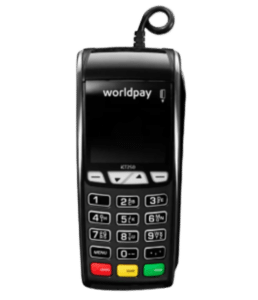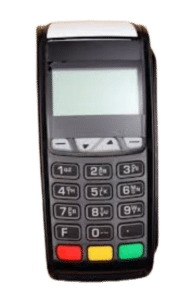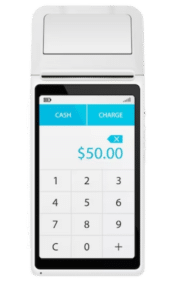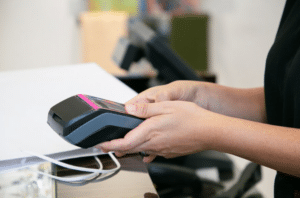What is a card machine?
Card machines (also called card terminals) are electronic devices that enable businesses to accept payments made with credit or debit cards.
Card machines were originally called PDQ machines when first introduced in the UK. Regardless of the terminology—be it card machines, card terminals, card readers, Chip and PIN, or PDQ machines—they all have the same purpose: to process card payments
Why does your business need a card machine?

In the UK, according to a recent survey, there are around 2.2 million card readers. This number indicates that more people are moving away from cash and prefer to pay with cards.
To keep up with the preferred payment method of most customers, you need to have a card machine to process cashless payments. When you expand your business to meet the needs of more people, your brand is deemed trustworthy, which also gives you an advantage over other businesses in the same industry.
Compare Card Machine Quotes Today
How does a credit card machine work?

Let’s take a look at how a credit card machine works step-by-step:
1. Initiating the transaction process
The merchant inputs the sale amount into the card machine, initiating the transaction process.
2 - Card presentation by the customer
The customer makes a contactless payment or use their card. For a quick, contactless payment, they simply tap their card on the machine, and for transactions requiring more security, they insert their card and enter their PIN.
3 - Secure communication
The chip on the customer’s card communicates with the machine, which encrypts and sends the transaction details to the merchant’s bank.
4 - Requesting approval
The merchant’s bank sends an authorisation request to the customer’s credit card network, which, in turn, seeks authorisation from the customer’s bank.
5 - Transaction verification
The credit card network verifies the card details and requests the customer’s bank to confirm the availability of sufficient funds or credit.
6 - Transaction completion
Upon successful authorisation, the machine notifies the merchant of a successful payment. Receipt printer prints our a receipt as proof of payment.
Types of card machines
There are many different types of card machines to choose from, including:
- Countertop
- Mobile
- Portable
Countertop card machines

Countertop card machines are directly connected to a phone line or internet connection, ensuring stable and reliable transactions.
Ideal for: businesses with a fixed sales point, providing a quick and efficient payment process for customers.
Functioning: Countertop machines quickly process card payments by securely transmitting data to the merchant’s bank for authorization and completion of the transaction.
Portable card machines

Portable machines operate wirelessly, typically through Wi-Fi or Bluetooth, allowing them to communicate with the central payment system from anywhere within the business premises.
Ideal for: restaurants, cafes, and businesses with takeaway ordering systems, where you need to take the card machine directly to your customers.
Functioning: The mobility allows for a unique payment process, where transactions are initiated and completed at the customer’s location, such as at a restaurant table. This enhances customer service by minimizing wait times and it also employs secure encryption methods to ensure that payment data is safely processed during each transaction.
Mobile card machines

Mobile card machines utilise cellular networks (GSM, 3G, 4G, etc.) to process payments, making them not reliant on a fixed internet or phone line connection. You can also attach a card reader with your phone via bluetooth and carry out transactions on the go.
Ideal for: businesses that are remote or operate temporarily in different locations. This includes food trucks, delivery services, taxi drivers, pop-up stores, or vendors at farmers’ markets.
Functioning: Mobile card machines process payments virtually anywhere there is mobile service coverage. They are equipped with the technology to securely send transaction data over cellular networks.
Make the Switch to Cashless Payments with ComparedBusiness
We at ComparedBusiness are experts in saving your time and money. Just submit your business requirements for card machines & EPOS systems in less than 2-mins and ComparedBusiness will get back to you with detailed quotes from a list of top card machine & EPOS system providers in the UK. You can pick and choose the best option for your business.
FAQs
Some of the reasons why a transaction might not work are listed below:
- First, there could be a technical issue somewhere in the process. If everything is okay on customer’s end, then maybe something went wrong with the systems that handle the payment.
- Second, the customer might not have enough money in their account or enough credit to pay for what they’re buying. If that’s the case, their bank won’t let the payment go through.
The only thing that’s different with contactless payments is that the customer doesn’t need to type in their PIN. They just tap their card on the machine, and after that, everything works the same way as other payments.
There’s no difference in how the machine processes transactions, whether it is with a debit or credit card. The steps are the same.
When picking a card machine provider, check out their fees, contract details, security features, and customer support. It’s also a good idea to check out the reviews and experiences of their previous clients; this can help you get an exact idea about their customer service.
Yes, some card machines let you accept payments in various currencies. This is great if you have international customers. Just check with your provider to see if this feature is available and if there are any extra fees.
If your card machine isn’t working, try restarting it and checking your internet connection. If it’s still not working, contact your provider’s customer support for help. They usually offer quick assistance to get things back on track.




